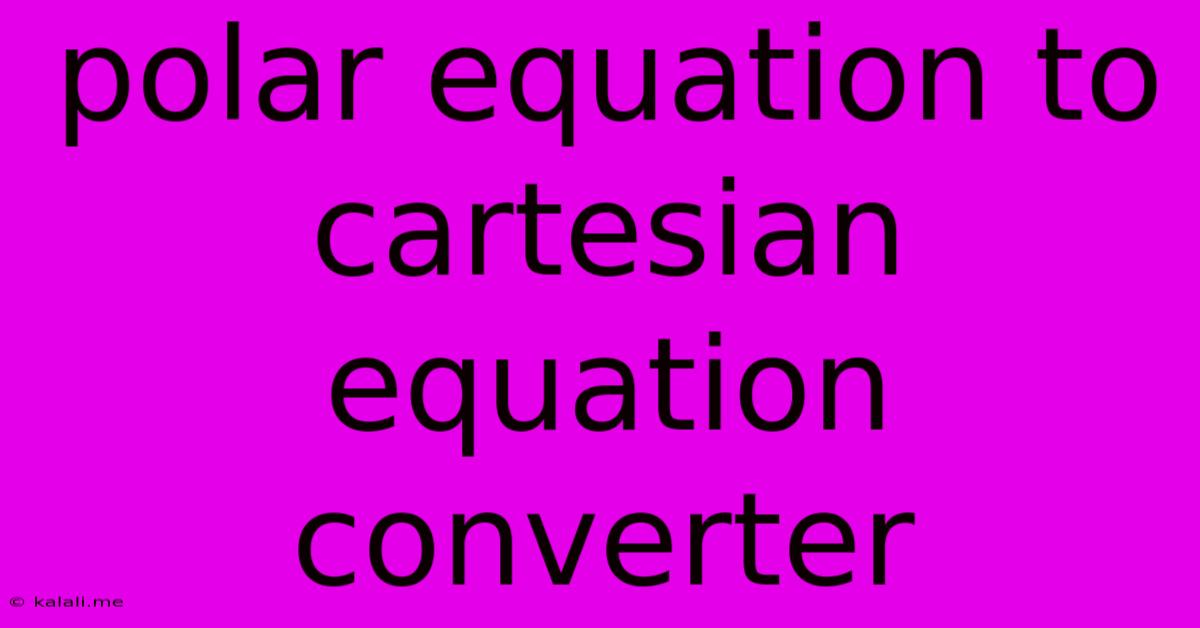Polar Equation To Cartesian Equation Converter
Kalali
May 29, 2025 · 3 min read

Table of Contents
Polar Equation to Cartesian Equation Converter: A Comprehensive Guide
Converting polar equations to Cartesian equations is a fundamental skill in mathematics, particularly useful in graphing and analyzing curves. This comprehensive guide will walk you through the process, providing examples and clarifying common challenges. Understanding this conversion allows you to leverage the strengths of both coordinate systems—the simplicity of polar coordinates for circular or spiral shapes and the familiarity of Cartesian coordinates for linear algebra and calculus.
Understanding the Coordinate Systems
Before diving into the conversion process, let's refresh our understanding of polar and Cartesian coordinates.
-
Cartesian Coordinates (x, y): These are the familiar rectangular coordinates, where a point is defined by its horizontal (x) and vertical (y) distances from the origin.
-
Polar Coordinates (r, θ): These coordinates represent a point using its distance from the origin (r, the radial distance) and the angle (θ, theta) it makes with the positive x-axis.
The Conversion Formulas: The Key to Transformation
The magic lies in these fundamental relationships:
- x = r cos θ
- y = r sin θ
- r² = x² + y²
- tan θ = y/x (Note: This equation only provides the angle, and you'll need to consider the quadrant to get the correct θ)
These formulas provide the bridge between the two coordinate systems. By substituting these equations into a polar equation, you can express it in terms of x and y, resulting in its Cartesian equivalent.
Step-by-Step Conversion Process
Here's a systematic approach to convert polar equations to Cartesian equations:
-
Identify the Polar Equation: Start with the equation written in polar form (using r and θ).
-
Substitute the Conversion Formulas: Replace 'r' and 'θ' with their Cartesian equivalents using the formulas above. Choose the appropriate formula based on the form of your polar equation. For example, if your equation involves
r, you'll likely user² = x² + y². If it involvesθ, you might usetan θ = y/x. -
Simplify the Equation: Use algebraic manipulation to simplify the resulting equation. This often involves trigonometric identities, factoring, and solving for y (if possible, to obtain a function of x).
-
Verify the Result: Check your work by plotting both the original polar equation and the converted Cartesian equation to ensure they represent the same curve.
Examples: Illustrating the Conversion
Let's illustrate the process with a few examples:
Example 1: Converting r = 5
This polar equation represents a circle with radius 5 centered at the origin.
-
Substitute: Since r = 5, we substitute this into
r² = x² + y²giving25 = x² + y². -
Simplify: This is already simplified and represents a circle with radius 5 centered at the origin in Cartesian coordinates.
Example 2: Converting r = 2cos θ
This equation represents a circle.
-
Multiply by r: We have
r² = 2r cos θ. -
Substitute: Using
x = r cos θandr² = x² + y², we getx² + y² = 2x. -
Simplify: Rearranging, we get
x² - 2x + y² = 0. Completing the square, we get(x - 1)² + y² = 1. This is a circle with center (1,0) and radius 1.
Example 3: Converting r = 1 + cos θ (Cardioid)
This represents a cardioid. This conversion is more complex and requires more trigonometric manipulation, often involving trigonometric identities. The final Cartesian form will be quite involved and is best left to a computer algebra system (CAS) for simplification. The process will involve substituting x = r cos θ and r² = x² + y² and simplifying through algebraic and trigonometric manipulations.
Advanced Considerations and Challenges
Some polar equations are notoriously difficult to convert to Cartesian form. In these cases, it might be more efficient to work directly with the polar equation. Additionally, the conversion might result in an implicit equation (not easily solved for x or y), representing a more complex curve.
Conclusion: Mastering the Conversion
Converting polar equations to Cartesian equations is a powerful technique for analyzing and graphing curves. By understanding the conversion formulas and applying the steps outlined above, you'll gain a deeper understanding of both coordinate systems and their applications in various mathematical contexts. Remember to leverage tools like graphing calculators or computer algebra systems when dealing with more intricate equations.
Latest Posts
Latest Posts
-
How To Find Septic Tank Lids
May 30, 2025
-
How To Do More Pull Ups
May 30, 2025
-
My Desert My Arrakis My Dune
May 30, 2025
-
Direction To A Newly Knighted Knight
May 30, 2025
-
Can Lesser Restoration Cure Permanent Blindness 5e
May 30, 2025
Related Post
Thank you for visiting our website which covers about Polar Equation To Cartesian Equation Converter . We hope the information provided has been useful to you. Feel free to contact us if you have any questions or need further assistance. See you next time and don't miss to bookmark.